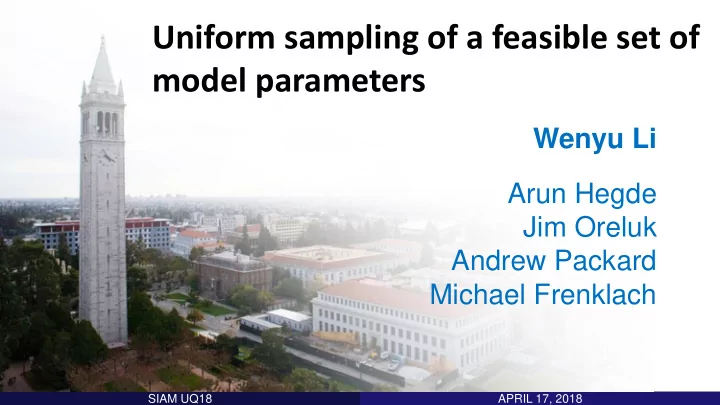

Uniform sampling of a feasible set of model parameters Wenyu Li Arun Hegde Jim Oreluk Andrew Packard Michael Frenklach SIAM UQ18 APRIL 17, 2018
Acknowledgements This work is supported as a part of the CCMSC at the University of Utah, funded through PSAAP by the National Nuclear Security Administration, under Award Number DE-NA0002375. SIAM UQ18 APRIL 17, 2018
Bound-to-Bound Data Collaboration (B2BDC) Model: Prior Uncertainty Data n Data n Data n Data 3 Data 2 Data 1 Feasible set SIAM UQ18 APRIL 17, 2018
Uniform sampling Goal: uniform sampling of feasible set • Sampling is useful in providing information about • B2BDC makes NO distribution assumptions, but as far as taking samples, uniform distribution of is reasonable • Applying Bayesian analysis with specific prior assumptions also leads to uniform distribution of as posterior [1] SIAM UQ18 APRIL 17, 2018
Rejection sampling method with a box Procedure: Procedure: • find a bounding box • find a bounding box Bounding box - available from B2BDC - available from B2BDC Circumscribed box • generate uniformly distributed samples in • generate uniformly distributed samples in the box as candidates the box as candidates • reject the points outside of feasible set • reject the points outside of feasible set Pros & Cons Pros & Cons • provably uniform in the feasible set • provably uniform in the feasible set • candidates can be drawn very efficiently • candidates can be drawn very efficiently Feasible set • efficiency drops quickly with increased dimension • efficiency drops quickly with increased dimension SIAM UQ18 APRIL 17, 2018
Random walk [2] (RW) Procedure: Procedure: Feasible set • start from a feasible point • start from a feasible point - available from B2BDC - available from B2BDC Extreme point • select a random direction, calculate extreme • select a random direction, calculate extreme New moving points and choose the next point uniformly points and choose the next point uniformly direction Moving Next point • repeat the process • repeat the process direction Starting Pros & Cons Pros & Cons point • NOT limited by problem dimensions • NOT limited by problem dimensions Extreme point • NOT necessarily uniform in the feasible set • NOT necessarily uniform in the feasible set SIAM UQ18 APRIL 17, 2018
Rejection sampling method with a polytope Procedure: Procedure: • find a convex bounding polytope • find a convex bounding polytope - available from B2BDC - available from B2BDC Feasible set Circumscribed • generate candidate points by random walk • generate candidate points by random walk polytope • reject the points outside of feasible set • reject the points outside of feasible set Pros & Cons Pros & Cons • provably uniform in the feasible set • provably uniform in the feasible set • increased efficiency with more polytope facets • increased efficiency with more polytope facets • limited by computational resource • limited by computational resource Bounding polytope SIAM UQ18 APRIL 17, 2018
Effect of polytope complexity • Polytopes with different complexity are tested • 5 million candidates are generated to calculate the efficiency and CPU time SIAM UQ18 APRIL 17, 2018
Effect of polytope complexity • Sampling efficiency increases with more complex polytope • The improvement is more significant at higher dimensions SIAM UQ18 APRIL 17, 2018
Truncation strategy Motivations • difference between a bounding and circumscribed polytope • existence of low-density tails along most of the directions Procedure • start with a bounding polytope and shrink the polytope bounds • recommended to stop when a practical efficiency is obtained SIAM UQ18 APRIL 17, 2018
Effect of truncation • A polytope is defined as: • The s are calculated [3] from B2BDC and represents a bounding polytope • s vary gradually to generate smaller polytopes SIAM UQ18 APRIL 17, 2018
Effect of truncation • Region of no truncation, improved sampling efficiency. [3] • Region of increased truncation, improved efficiency but acceptable approximation • Region of unacceptable approximation SIAM UQ18 APRIL 17, 2018
Check of directional histograms Due to the conservative estimation in Low-density tails • This is observed along all the directions defining the polytope • The distribution has zero-density regions • The distribution has low-density tail regions SIAM UQ18 APRIL 17, 2018
Principal component analysis (PCA) Feasible set Procedure: Procedure: • collect RW samples from the feasible set • collect RW samples from the feasible set • conduct PCA on RW samples • conduct PCA on RW samples • find a subspace based on PCA result • find a subspace based on PCA result • generate uniform samples in the subspace • generate uniform samples in the subspace Pros & Cons Pros & Cons • improves sampling efficiency significantly • improves sampling efficiency significantly • works only if feasible set approximates a • works only if feasible set approximates a lower-dimensional manifold/subspace lower-dimensional manifold/subspace Lower-dimensional subspace SIAM UQ18 APRIL 17, 2018
Effect of dimension reduction Principal direction index • efficiency is affected mostly by problem dimension the (2.96e-5 in full dimension) • returned samples approximate the desired distribution with acceptable accuracy only when the smallest principal direction is truncated SIAM UQ18 APRIL 17, 2018
Summary • We developed methods to generate uniformly distributed samples of a feasible set • Truncation strategy and PCA further improves the sampling efficiency of the method • Numerical results support an advantageous efficiency- accuracy trade-off of the proposed approximation techniques SIAM UQ18 APRIL 17, 2018
Reference [1] Frenklach, Michael, et al. "Comparison of statistical and deterministic frameworks of uncertainty quantification." SIAM/ASA Journal on Uncertainty Quantification 4.1 (2016): 875-901. [2] Smith, Robert L. "Efficient Monte Carlo procedures for generating points uniformly distributed over bounded regions." Operations Research 32.6 (1984): 1296-1308. [3] Gretton, Arthur, et al. "A kernel two-sample test." Journal of Machine Learning Research 13.Mar (2012): 723-773. SIAM UQ18 APRIL 17, 2018
Recommend
More recommend